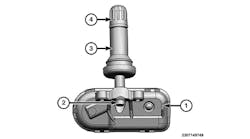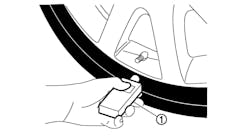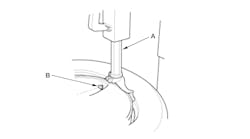SUBJECT VEHICLES: 2012-2017 Volkswagen Passat
RELEARN PROCEDURE? Yes.
SPECIAL TOOLS NEEDED? No.
The tire pressure monitoring system (TPMS) in the 2012-2017 Volkswagen Passat is the indirect type, and is included in the software of the anti-lock braking system (ABS) control module.
The system will recognize a slow and gradual decrease in tire pressure on a wheel. The diagnostic trouble code (DTC) memory faults for tire pressure monitoring are stored in the ABS control module. With the help of the ABS speed sensor, the TPMS compares the speed and rolling circumference of the individual wheels. There are no sensors installed in the vehicle’s tires.
Rolling circumference of a tire may change due to:
- Insufficient tire pressure.
- Structural damage on tires.
- The vehicle is loaded heavily on one side.
- One axle is heavily loaded (i.e., when pulling a trailer).
- When snow chains are used.
- When a spare tire is installed.
- One wheel is replaced.
Tire pressure monitor warning indicator
TPMS warnings are shown via a TPMS indictor light on the instrument panel. When the low tire pressure warning light comes on, air pressure of all tires should be immediately checked and adjusted to the specified pressure. Reset the TPMS. If the light is still on, there is a malfunction in the TPMS. See the appropriate manufacturer service information.
If the anti-slip regulation (ASR)/electronic stability program (ESP) control lamp or the traction control indicator lamp indicates a malfunction in the ABS system, then the TPMS indictor light will also illuminate. A malfunction in the tire pressure monitoring system has not been stored. The TPMS indictor light cannot be turned off by pressing TPMS SET Button. See the appropriate manufacturer service information.Reset procedures
NOTE: Whenever a wheel is changed or replaced, tire pressure adjusted, or the tires rotated, the TPMS needs to be reset. When the low tire pressure warning light comes on, immediately check the air pressure of all the tires and adjust them to the specified pressure. Reset the TPMS. Ensure that warning indicators are not displayed.
Tire pressure monitory system reset
CAUTION: DO NOT reset the TPMS until all problems are fixed and tire pressure in all tires has been adjusted. If the reset procedure is done when the tire pressures are incorrect, the TPMS will not work properly and may not set an alert when a tire pressure is low or high.
1) Set the tire pressure of all wheels to the specified pressure.
2) With the vehicle stopped and the parking brake applied, turn the ignition switch to the ON position.
3) Press the TPMS SET button (located inside the glove compartment) until an audio signal is heard. The signal confirms the basic setting.
Demounting/mounting procedures
CAUTION: The tire should be demounted from the wheel using the tire changer manufacturer’s instructions.
NOTE: The vehicles is equipped with an indirect TPMS. The indirect system does not use tire pressure sensors installed on the four wheels.
NOTE: Whenever a wheel is changed or replaced, the tire pressure is adjusted, or the tires are rotated, the TPMS needs to be reset. See “Reset procedures.” ■
Torque specifications
Component Ft.-lbs. (N.m)
Wheel nut 103 (140)
Information for this column comes from Mitchell 1’s “Tire Pressure Monitoring Systems Guide” for domestic and import vehicles. Headquartered in Poway, Calif., Mitchell 1 has provided quality repair information solutions to the automotive industry for more than 80 years. For more information, visit www.mitchell1.com.
To read more TPMS articles, see:
2017 Nissan Rogue and Rogue Select




